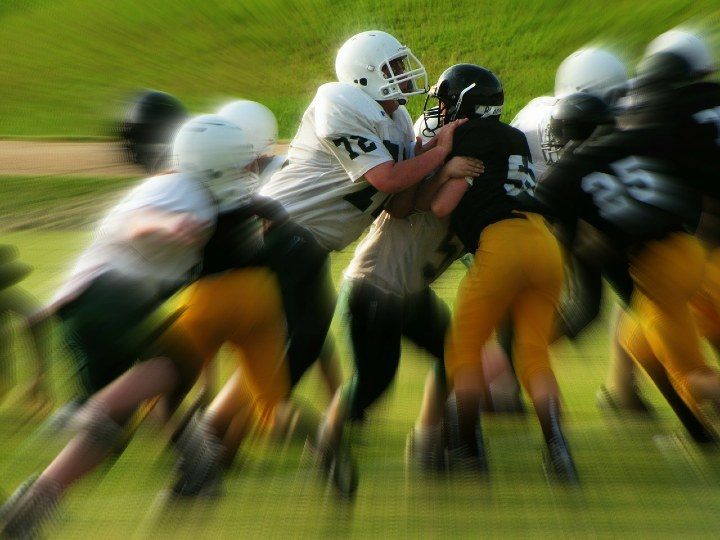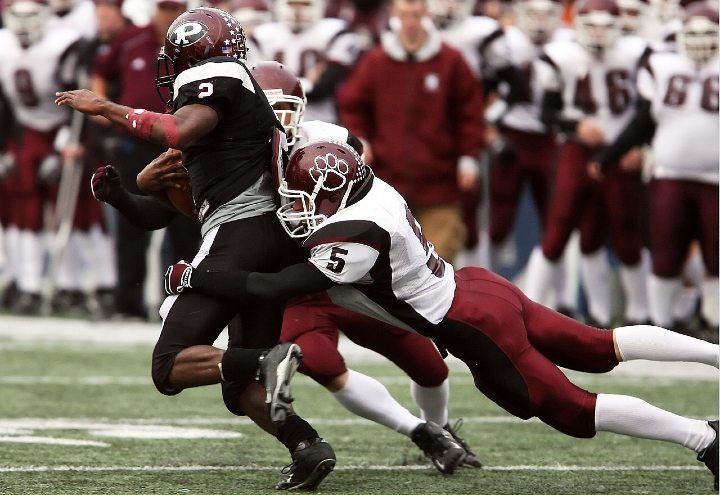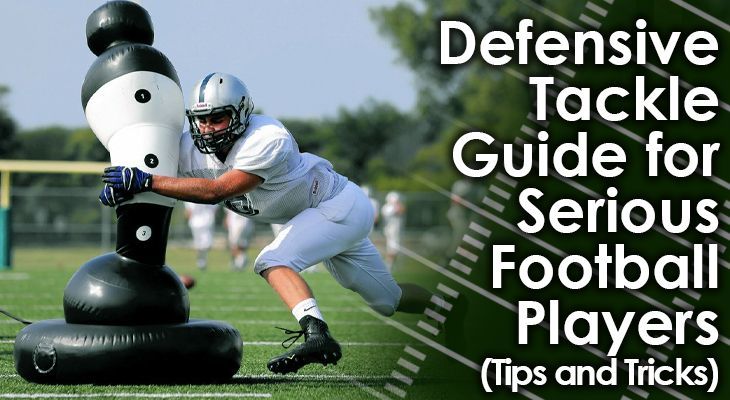Defensive tackles are often the forgotten players along the line of scrimmage.
Defenses focus on applying pressure on the offense, which all starts up front with the big men at the line.
Despite this, much of the attention and recognition go to the defensive ends because they rack up the stats in the categories that grab headlines.
For people who play the defensive tackle, though, it's quite alright that they don't get the public notoriety…
They know how valuable they are to their team.
And their coaches do, too.
Let’s take a closer look at what makes a great tackle, what they do on the field, and some of the best ones to ever play the game of football.
What is a Defensive Tackle in Football?
Defensive tackles are big yet agile defensive linemen who line up closest to the middle of the D-Line, on virtually every play.
These players can completely disrupt everything an offense attempts to do.
He can force a lot of attention along the line of scrimmage, which frees up those defensive ends, linebackers and even members of the secondary to make massive plays.
Not every football player is a great fit to be a defensive tackle, though.
It's a defensive line position that requires a lot of size and strength, but it also requires a player to be nimble and quick.
Defensive Tackle Position on the Field
More often than not, defensive tackles line up between two defensive linemen – particularly the spaces between the center and offensive guards.
This is why they find themselves battling for position against different combinations of offensive linemen on just about every play.
Their position, however, allows defensive tackles to disrupt the offense upfront and get the focus of multiple offensive linemen.
They do this in order to free up other defenders rushing to the backfield – like defensive ends and linebackers.
Being in the middle of all that contact, they work tirelessly to fight through the line and create as much disruption as they can for the players in the backfield.
What Does a Defensive Tackle Do?
A defensive tackle has a wide range of roles and responsibilities.
Here are a few of them:
1. He Must Initiate the Contact
In order for a defensive tackle to be successful, he must be the aggressor in the contact.
He needs to have great anticipation and vision in order to time the snap of the ball just right, so that he can get off the ball with explosive power right away.
If he's able to do this, he will be putting the pressure on the offensive linemen to react to his movements.
If it's the other way around, it becomes very difficult for a defensive tackle to get any kind of leverage -- and that leverage is so essential for defensive tackles.
It may seem odd, but defensive tackles need to play offense, rather than playing defense, in a sense.
He needs to approach every play as if he's the one attacking, and not the other way around.
2. He Must Attract Attention
A defensive tackle's primary responsibility is to attract attention from as many offensive linemen as possible.
The more offensive linemen he is occupying, the more free space there will be for other defenders to roam free and make plays.
This won't get a defensive tackle noticed in headlines or on the stat sheet.
What it will do is allow other players to do just that.
No linebacker will be able to make plays if he is gobbled up by an offensive lineman that was able to get to the second level because a defensive tackle was easily blocked by just one person.
The way a defensive tackle attracts attention is by being disruptive, bursting through the line of scrimmage, being quick off the ball and hard to move.
Ultimately, if a defensive tackle is living up to all his traits, he'll require the attention of two blockers on every play.
3. He Must Fill Holes
At some point during the play, a defensive tackle will need to ultimately shed blocks to try to make a play.
He won't often make a tackle or sack, but it'll be necessary for him to pursue ball carriers or force them to other areas of the field.
On most plays, a defensive tackle will be assigned a “gap” along the line of scrimmage to fill.
His primary responsibility will be to plug that gap any way he can.
He cannot be moved away from that gap, otherwise there will be open running room.
Then, he must have the vision and awareness to see the play as it's developing to see whether he must shed the block and run to a different part of the field for support.

5 Successful Defensive Tackle Traits
If you’re looking to take your game as a defensive tackle to new heights, here are a few traits to work on:
1. Defensive Tackles are Big
The biggest players on the defense will inevitably be defensive tackles.
Some of the best defensive tackles in NFL history have tilted the scales at more than 300 pounds.
The reason defensive tackles need to be so large is because they must be immovable objects.
In other words, a defensive tackle needs to make it difficult for offensive linemen to move him where they want to.
One easy way to do that is to simply be big.
The heavier something is, the harder it is to move.
That's a pretty simple concept to understand, and that's why defensive tackles are often some of the heaviest players on the field -- on either side of the ball.
2. Defensive Tackles are Quick
Although they need to be big, defensive tackles need to be quick, too.
They need to put pressure on the offensive line by their movements -- not just by their physical stature.
Eventually, offensive linemen will be able to move a big object, but it's difficult for them to move one that is quick and moving around.
A lot of attention on the defensive side of the ball is given to speed.
It's a trait that players in the secondary, linebackers and even defensive ends need to have to succeed.
For defensive tackles, it's more important to have quickness.
The first two steps that a defensive tackle takes after the ball is snapped are the most important to how the play goes.
These steps will determine whether he will be making his way through the line of scrimmage, whether a second offensive linemen will be required to help block him, or whether he'll be easy to block.
Tackles need to have superior quickness so they can be the ones initiating the first contact with offensive linemen, and not the other way around.
This will give them leverage throughout the entire play.
3. Defensive Tackles are Strong
Defensive tackles line up to the interior of the line of scrimmage.
They will often take on double-team blocks from offensive linemen -- either a combination of a center and guard, or a guard and offensive tackle.
Their job is to fight off these blocks, and attract as much attention from offensive linemen as possible.
Doing so frees up other players to roam around on the field.
The way they do this is by using their arms and hands.
They need to keep offensive linemen away from their bodies.
If they can maintain space between them and the blocker, then they'll be able to succeed in pushing the line into the backfield.
If they can't, then they'll be much more susceptible to getting pushed back.
This is why a lot of the individual drills that defensive tackles do in practice focus on swatting away blockers' hands and keeping that physical separation.
To do this successfully on a consistent basis, defensive tackles need to be very strong – especially in their arms and hands.
4. Defensive Tackles are Durable
On every single play, a defensive tackle will get involved in high-impact contact.
There is simply no way around it.
He will engage head-on collisions with offensive linemen on every play as they try to push him back and he tries to push them forward.
He'll also take a lot of contact from different angles.
Sometimes, he'll take on double-team blocks from the side.
Sometimes, he may get a hit from behind as a linebacker rushes to the line of scrimmage to plug a hole.
In many cases, defensive tackles will get tangled up in pile-ups around the ball.
As such, they need to be durable, and be able to withstand all this physical contact.
If they can't, they won't be able to contribute to their team by staying on the field play after play.
5. Defensive Tackles are Consistent and Focused
Defensive tackles must be reliable.
The defense will rely on them to put pressure on the offensive line on every play.
They can't afford to take even one play off, otherwise the offense could be in for a huge play.
It's a heck of a lot to ask of a player – to constantly give 100% when they're getting physically battered and exhausted.
But it's so important.
It's what separates defensive tackles from other players.
To do this, they need to have mental toughness, the ability to focus and the ability to rally when things are getting tough.
They need to be determined to succeed on each and every play, no questions asked.
Best Defensive Tackles of All Time
With a long list of all-time great DTs known to have disrupted offenses week after week, it’s quite a challenge to rank them all.
Here’s my take a ranking the top 10 best defensive tackles of all time:
1. Aaron Donald
2. Bob Lilly
3. Joe Greene
4. Warren Sapp
5. Merlin Olsen
6. Randy White
7. Cortez Kennedy
8. John Randle
9. Buck Buchanan
10. Geno Atkins
3 Defensive Tackle Tips
1. Work on Footwork
The feet are so important for a defensive tackle if he wants to be quick.
Unlike some other players at different positions, defensive tackles don't need to work on sprinting and getting fast on a straight-line basis.
They do, however, need to make sure that they are quick off the ball.
The best way to do this is to work on footwork drills.
This includes shuffling, backpedaling and other ladder drills.
Defensive coaches will integrate these drills into practice.
2. Work on Handwork
The second skill defensive tackles need to acquire is the ability to swat away blockers' hands and arms -- to keep that spacing between them that we were talking about before.
In a way, this is a little bit like martial arts.
They'll need to use their hands to swat away the hands of the blocker.
This is such an important skill to acquire.
A defensive tackle can be big, strong and quick, but if a blocker is able to get his hands on the tackle's body, then he'll be able to gain the leverage necessary to move him off his path.
3. Work on Flexibility
Defensive tackles will often be attacking and moving through the line of scrimmage at angles that are not very natural.
They will start low to the ground in a three-point stance, and they need to try to keep low throughout the entire play to gain this leverage.
They need to twist and turn their bodies at different angles.
And they must do all of this without injuring themselves.
That's why stretching is very important for defensive tackles.
Working with a coach who can help them stretch, as well as working with elastic bands to stay flexible is key.

Conclusion
Defensive tackle is one of the most thankless football positions on a football field, but it's also one of the most important.
A great defensive tackle can completely change the outcome of a game.
They don't often appear on the stat sheet or in headlines, but what they do allows other players on the defense to shine.
If a defensive tackle is able to do their job properly, then defensive ends and linebackers will be able to have a field day causing havoc for the offense.
Not every player can be a defensive tackle.
The position takes a combination of size, strength, quickness and flexibility that is hard to teach.
If you have this size and the mental toughness to handle it, defensive tackle can be one of the most rewarding defensive positions to play.

